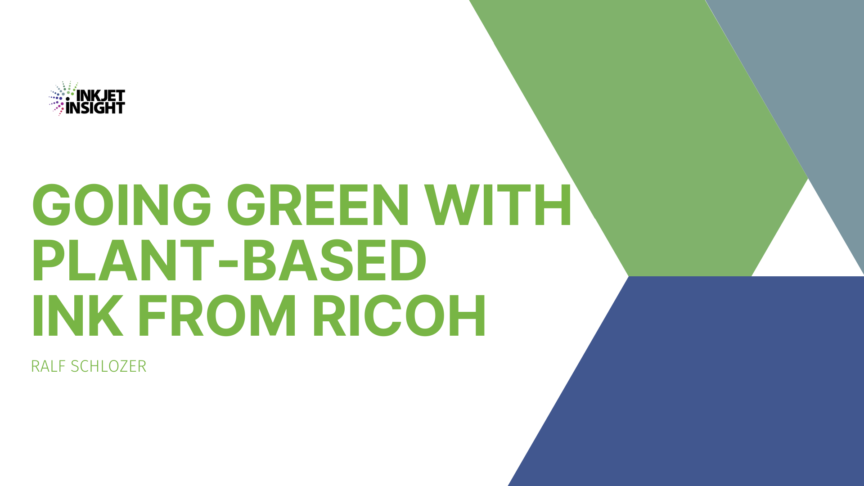As many know, Ricoh is not only a manufacturer of a range of inkjet printers, Ricoh also provides components like inkjet heads, inks, software and system integration services to other companies who use these components for their own inkjet products in a wide range of markets. While Ricoh inkjet heads are utilised widely by integrators for many years now, ink offerings (without a head) are lesser known.
The announcement of a new plant-based ink is set to change this now. In contrast to the widely used aqueous or UV inkjet inks the new ink is oil-based. Being plant-based in addition makes it a first in mainstream graphics and packaging print. The ink uses soybean for the oil component, which should make it a sustainable and environmentally friendly option.
The ink developed by Ricoh is a derivative of the existing oil-based ink for the décor printing sector – part of the joint development with German company Olbrich for an inkjet press for vinyl-based wallpaper. The new ink has already been tested and Ricoh has a high degree of confidence in its use. It builds as well on Ricoh’s expertise in oil-based inks for duplicators.
Drying of the ink is straightforward: according to Ricoh there is no heat required to fix or dry the ink. The oil is simply penetrating into the substrate leaving the pigment on the top. This saves not only energy, it saves the need for the whole drying system. The downside is that the ink is only suitable for porous materials, such as paper, board or corrugated, but not for flexible film. Gloss coated papers and boards are still being tested and might require a primer.
Ricoh sees several advantages compared to aqueous inks. The open time in heads is much longer, so there is less danger of clogging and less cleaning needed. As no water is contained, there is no need for biocides to keep the ink usable. Another feature is a low ink consumption than an equivalent water-based ink. After tests Ricoh expects that users should be able to achieve the same optical density with about 50 % less ink. Finally, no dryer or drying energy is required.
Compared to UV inks no monomers are used, accordingly it is environmentally friendlier, there is no odour and an improved food compatibility. Again, no dryer or drying energy is needed.
Overall, there are several positive environmental effects the new ink has:
- Oil is from sustainable resources
- Lower ink consumption
- Oil is biodegradable, which helps deinking as well
- Compared to UV inks no monomers are required
- No need for a drier
- Lower energy consumption as no active drying is needed
Ricoh cited an example calculation for switching from aqueous inkjet to the plant-based ink. For an installation with a 500 mm print width and 50 m/min speed a total of €65,000 in electricity and 150 tons of CO2 could be saved annually.
According to Ricoh the ink can be used with or without primer. The primer would improve colour gamut and resistance. As the primer is white, it could improve the quality on coloured substrates (corrugated) as well. The primer is applied as flood coating. So far only CMYK inks are available and adding more inks will depend on the success of the plant-based ink.
The ink is already available to interested parties and several partners have already run trials. Various fields of applications are possible, especially in the packaging market. While there is no clear front-runner, corrugated could be among the first areas of use. So far, no fields of applications are ruled out by Ricoh on where the ink could be or should not be used.
There is no application using the Ricoh plant-based ink today. The Olbrich wallpaper printer will continue to use the mineral-oil-based ink – at least for some time. Like for prospective users of inkjet heads, Ricoh can support custom developments for potential users of the new ink.
As expected, there are no details on pricing. According to Ricoh, the price will be competitive. This comes down to a slightly higher price per litre than comparable inks, outweighed by the advantages in yield, drying cost and environmental benefits.
The environmental benefits make the plant-based ink from Ricoh very promising, as the environmental focus of printers and brand owners is increasing rapidly. There are some convincing arguments why the new ink has an edge here.
There might be some downsides in practice. Adherence to substrate and rub-off might be lower than other inks, although Ricoh has not seen problems so far. The primer could help however, this would reduce the environmental benefits somewhat. Print speed and coverage might be somewhat limited, although Ricoh tested the ink for speeds up to 70 m/min, which is a pretty decent speed already.
In any case the new ink is an interesting approach. Hopefully first applications can be seen in 2022.

